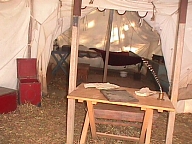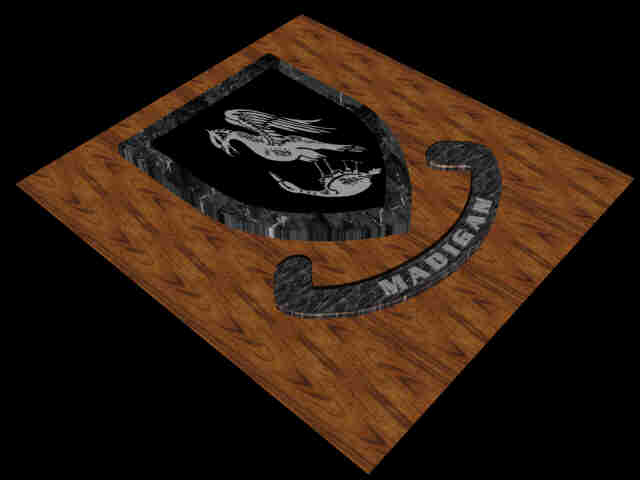Waiting at the entrance to
the York River was Admiral  de Grasse having arrived from the French West
Indies. The battle of the Capes at the mouth of the Chesapeake
found the arriving British badly outgunned from an overwhelming
number of French ships. Admiral Graves eventually decided to
withdraw and returned to New York with what ships and men he had
left. As he sailed north, as is often the case at sea, he had no
knowledge of the French ships passing by over the horizon under
the command of Admiral de Barras, who had set sail from Quebec
with Washington's last big surprise. Washington, now encircling
Yorktown, made no real effort to attack the fortifications made
up of a series of readouts around the city. His men were busy
digging firing pits for the French presence being unloaded just
North of the city. Large siege guns from the Quebec
fortifications capable of blasting through just about anything
being built by man at that time. Cornwallis, now realizing that
the water route was blocked and facing twice his complement in
the field, withdrew from his outer parameter, abandoning
de Grasse having arrived from the French West
Indies. The battle of the Capes at the mouth of the Chesapeake
found the arriving British badly outgunned from an overwhelming
number of French ships. Admiral Graves eventually decided to
withdraw and returned to New York with what ships and men he had
left. As he sailed north, as is often the case at sea, he had no
knowledge of the French ships passing by over the horizon under
the command of Admiral de Barras, who had set sail from Quebec
with Washington's last big surprise. Washington, now encircling
Yorktown, made no real effort to attack the fortifications made
up of a series of readouts around the city. His men were busy
digging firing pits for the French presence being unloaded just
North of the city. Large siege guns from the Quebec
fortifications capable of blasting through just about anything
being built by man at that time. Cornwallis, now realizing that
the water route was blocked and facing twice his complement in
the field, withdrew from his outer parameter, abandoning it to the Colonialists. With time on his hand Washington took
pains to prepare a proper siege of the town. Then with all
preparations completed, on October 9th of 1781, Washington
honored the French General Rochambeau, commander of the French
detachment with firing the first shot of the last major battle of
the Revolutionary War. After that it was a continuous bombardment
of the city and its defenders. For nine days the round-the-clock
shelling continued. At one point Cornwallis attempted to execute
his last escape plan by ferrying his forces across the York River
in hopes of slipping away. After about a 1000 men escaped, a
storm wrecked the plans sending many of the small boats to the
bottom. With only 70 of the 661 buildings
it to the Colonialists. With time on his hand Washington took
pains to prepare a proper siege of the town. Then with all
preparations completed, on October 9th of 1781, Washington
honored the French General Rochambeau, commander of the French
detachment with firing the first shot of the last major battle of
the Revolutionary War. After that it was a continuous bombardment
of the city and its defenders. For nine days the round-the-clock
shelling continued. At one point Cornwallis attempted to execute
his last escape plan by ferrying his forces across the York River
in hopes of slipping away. After about a 1000 men escaped, a
storm wrecked the plans sending many of the small boats to the
bottom. With only 70 of the 661 buildings in Yorktown still standing, Cornwallis accepted
the inevitable. Surrender or die. On the morning of October 19th,
above the sound of the continuous blast of cannon, could be heard
the sharp rap of an advancing British drummer. As the sound
approached the Colonial lines, gunners were greeted by the sight
of a lone British Lieutenant, walking behind the drummer with
sword held high flying the white flag of surrender. And so the
battle would end, and with it all desire in England to continue
pouring money into an obviously hopeless situation. The final
arrangements would drag on for another two years until in 1783
the Treaty of Paris officially ended hostilities.
The Victory Center covers more than the last battle of the
Revolutionary War. There is
in Yorktown still standing, Cornwallis accepted
the inevitable. Surrender or die. On the morning of October 19th,
above the sound of the continuous blast of cannon, could be heard
the sharp rap of an advancing British drummer. As the sound
approached the Colonial lines, gunners were greeted by the sight
of a lone British Lieutenant, walking behind the drummer with
sword held high flying the white flag of surrender. And so the
battle would end, and with it all desire in England to continue
pouring money into an obviously hopeless situation. The final
arrangements would drag on for another two years until in 1783
the Treaty of Paris officially ended hostilities.
The Victory Center covers more than the last battle of the
Revolutionary War. There is a small 17th century town complete with many
costumed presenters doing what 17th century people would be
doing. We stopped for a while and talked with a lady who was
drying tobacco as they did back then. The Victory Center is just
one of the many things to do in this historic town.
The military camp at the rear of the exhibition galleries was a
beehive of activities, as soldiers came and went on their daily
assignments. At the point where they fire the big 12 pound
cannon, a call for a volunteer went out and Laura stepped
forward. Her job was to call out the commands as relayed by the
battery commander. With clear and forceful voice she commanded
the firing order to load and aim.
It would take several days to see it all. I would put it on the
"must see" list should you find yourself in eastern
Virginia.
a small 17th century town complete with many
costumed presenters doing what 17th century people would be
doing. We stopped for a while and talked with a lady who was
drying tobacco as they did back then. The Victory Center is just
one of the many things to do in this historic town.
The military camp at the rear of the exhibition galleries was a
beehive of activities, as soldiers came and went on their daily
assignments. At the point where they fire the big 12 pound
cannon, a call for a volunteer went out and Laura stepped
forward. Her job was to call out the commands as relayed by the
battery commander. With clear and forceful voice she commanded
the firing order to load and aim.
It would take several days to see it all. I would put it on the
"must see" list should you find yourself in eastern
Virginia.
For more information
about this adventure, check out www.historyisfun.org
***THE END ***

